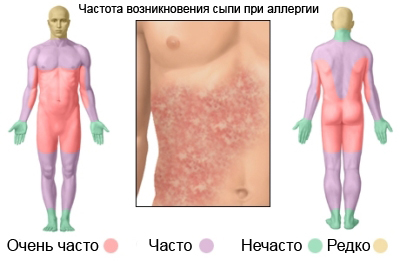Anaphylaxis – Anaphylactic reaction
description anaphylaxis
Anaphylactic shock is a severe, sometimes life-threatening allergic reaction.
The causes of anaphylactic shock
Substances, that cause anaphylaxis are called allergens or triggers. are common triggers:
- Food and supplements, especially eggs, peanuts, seafood, cow's milk, soy, fish, shellfish and nuts;
- Insect bites – Bees, OS, Hornets, gadfly, or ants;
- Drugs (eg, antibiotics, anticonvulsants, muscle relaxants);
- Vaccines;
- Objects made of latex (eg, gloves, medical tubing, condoms).
Risk factors
Factors, which increases the risk of anaphylactic shock:
- An allergic reaction to a substance, above, even if it is weak;
- Presence of the past – eczema, hay fever, or asthma;
- Children, who have certain diseases, such as spina bifida and defects of the genitourinary system, may have an increased risk of latex allergy (because of the strong influence of objects made of latex for multiple operations).
Symptoms of anaphylactic shock
Anaphylaxis symptoms usually occur within a few minutes after exposure to allergen, but may occur a few hours. Symptoms may be mild or very severe, including death. These include:
- Rash and itching;
- Edema, redness, tingling or burning sensation, especially the face, mouth, eyes or hands;
- Dizziness, caused a decrease in blood pressure;
- Nasal discharge, mouth and throat;
- Severe respiratory failure;
- Refine in Gruda, breathlessness, wheezing;
- Nausea, vomiting, convulsions, diarrhea;
- Cardiac arrhythmia;
- Convulsions;
- Low blood pressure, shock.

Diagnosis anafilakticheskogo shock
Diagnosis is based on symptoms. Vrach zapodozrit anafilaksiyu, If symptoms are present, and there was a recent contact with an allergen. To clarify the diagnosis possible referral, who specializes in allergies (allergist / immunologist).
Treatment of anaphylactic shock
Anaphylaxis is a medical emergency. Treatments include:
- Epinephrine injection (adrenaline) constrict blood vessels, relax the airways, stopping the itching and rashes, relieves cramps of the gastrointestinal tract;
- Corticosteroids and / or antihistamines may be administered after epinephrine to reduce inflammation and improve breathing;
- Bronhorasshiriteli – to improve breathing;
- intravenous fluids;
- Oxygen;
- Cardiopulmonary resuscitation (SLR) It may be needed in severe cases, when anaphylaxis leads to cardiovascular disease. Heavy anaphylactic shock may require mechanical ventilation, until the swelling will not pass.
Prevention anafilakticheskogo shock
Avoiding substances, that trigger anaphylaxis is the best prevention. Besides:
- injections of allergens (immunotherapy) can reduce the risk of anaphylaxis and reduce the severity of reactions to certain triggers;
- You must tell the doctor or dentist about the presence of allergies, before taking any medication. When possible, better to take medication in pill form. Allergic reactions may be more severe if the drug injections;
- The doctor can give an injection of adrenaline, to use it in case of emergency;
- You must make sure, the nurse in kindergarten, Schools and teachers are aware of the presence of allergies in children;
- If you have an allergy to insect bites, outdoors should wear clothing which protects the body;
- One should always be a doctor or dentist for 30 minutes after the injection. At occurrence of any allergic symptoms, you must report it.
